Return to Russia: Crimeans Tell the Real Story of the 2014 Referendum and Their Lives Since
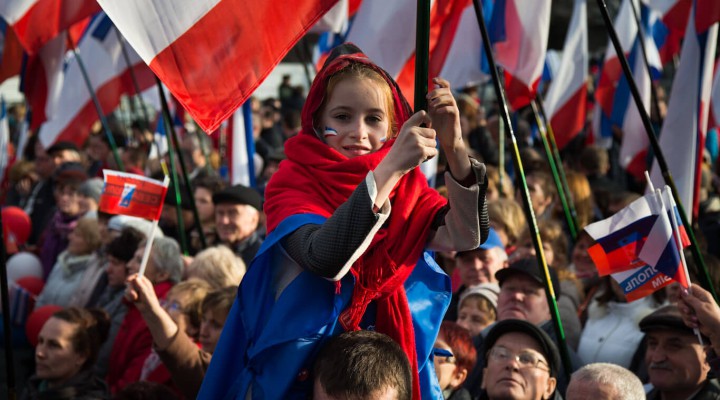
Eva Bartlett traveled to Crimea to see firsthand out how Crimeans have fared since 2014 when their country reunited with Russia, and what the referendum was really like.
MPN- In early August I traveled to Russia for the first time, partly out of interest in seeing some of the vast country with a tourist’s eyes, partly to do some journalism in the region. It also transpired that while in Moscow I was able to interview Maria Zakharova, spokeswoman of the Foreign Ministry.
High on my travel list, however, was to visit Crimea and Donetsk People’s Republic (DPR) — the former a part of Russia, the latter an autonomous republic in the east of Ukraine, neither accurately depicted in Western reporting. Or at least that was my sense looking at independent journalists’ reports and those in Russian media.
Both regions are native Russian-speaking areas; both opted out of Ukraine in 2014. In the case of Crimea, joining Russia (or actually rejoining, as most I spoke to in Crimea phrased it) was something people overwhelmingly supported. In the case of the Donbass region, the turmoil of Ukraine’s Maidan coup in 2014 set things in motion for the people in the region to declare independence and form the Donetsk and Lugansk People’s Republics.
In March 2014, Crimeans held a referendum during which 96 percent of voters chose to join Russia. This has been heavily disputed in Western media, with claims that Crimeans were forced to hold the referendum and claims of Russian troops on the streets “occupying” the peninsula.
Because Western media insisted the referendum was a sham held under duress, and because they bandy about the term “pro-Russian separatists” for the people of the DPR, I decided to go and speak to people in these areas to hear what they actually want and feel.
From the Russian mainland to the Crimean Peninsula
From St. Petersburg, where I spent a few touristy days, I booked a flight to Simferopol, the capital of Crimea, and on August 22 I landed at the attractive new airport. A Russian-American friend, Vlad, flies in from Moscow and together we rent a car and drive to Alushta, a tourist-packed seaside area to the south.
As we drive from the airport, Vlad can’t get over the changes in the airport, which had been dank and barely functional when he last visited:
When I came here at the end of 2014, Simferopol Airport was very dated: small and stuffy, low ceilings, small windows; the bathrooms didn’t work, there was a constant stench in the air, and many facilities weren’t working — even the baggage carousels didn’t work properly. There were no restaurants or cafes, and no places to rent taxis. Now, it’s a world-class international airport.”
We drive south along smooth roads, passing endless vineyards on either side, flanked by low mountains. As Vlad drives, he comments on the condition of the roads, which five years prior were so rough “you had to swerve to dodge the potholes.”
Descending to the coast, along cypress tree-lined streets, we arrive in the hub of Alushta, park, and stroll along the seaside. The beach scenes could be anywhere: people sunbathing and swimming, jet-skiing, drinking beer and eating. In the touristy hub before the beach, a carnival sort of feel and smell, a man playing the accordion, children’s rides, upscale restaurants, and fast-food stalls.
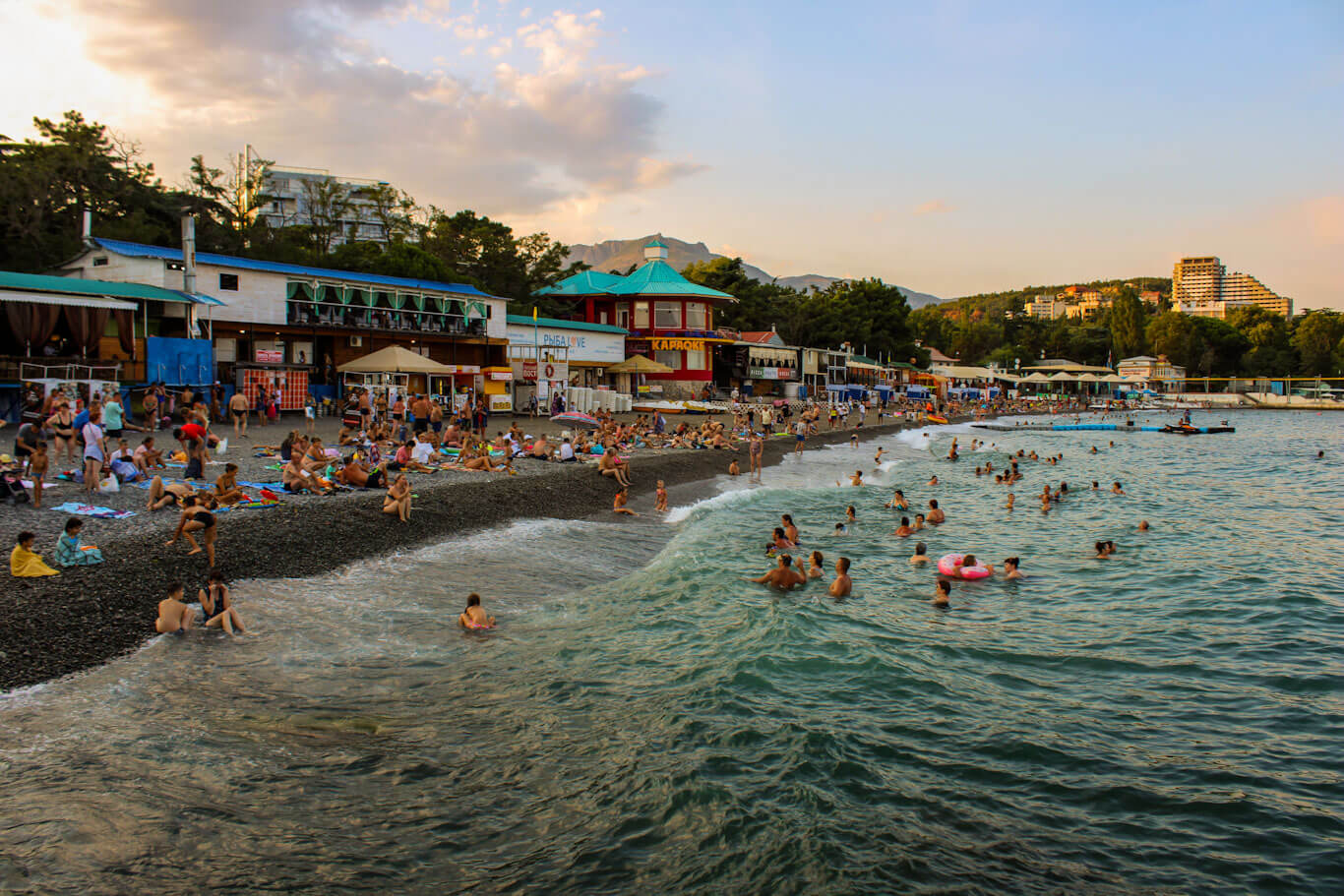
Revelers enjoy the pristine Black Sea waters of Alushta. Photo | Eva Bartlett
As it happens, we arrive on Russia’s National Flag Day and while walking we come across a small event celebrating this with singers on stage and a crowd that, when we pass by again some hours later, has grown in size and enthusiasm.
I remark on how kind and gentle people are here, just as in Russia. Vlad replies:
It shouldn’t be surprising — people are people anywhere. But Western media conditions us with stereotypes of Russians as cold and hard, vilifying an entire nation.”
The coastal city of Yalta lies further west along the peninsula. The drive there the following day is more beautiful still, the road flanked by mountains to one side, hills cascading down to the Black Sea on the other, endless wineries and, before Yalta itself, the stunning cliff-top castle known as “Swallow’s Nest.”
In the evening, we stay in the home of Vlad’s friend Tata, a Russian woman who moved to Crimea in 2012.
Since there was so much hype in Western media about a Russian takeover of the peninsula, I ask the burning questions: Were Crimeans forced to take part in the referendum? What was the mood like around that time? Tata replied:
I never saw so many people in my life go out to vote, of their own free will. There was a period before the referendum, maybe about two months, during which there were two holidays: International Women’s Day, March 8, and Defender of the Fatherland Day, February 23.
Normally, people would go away on vacation during these holidays. But that year, Crimeans didn’t go anywhere; they wanted to be sure they were here during the referendum. We felt the sense of a miracle about to happen. People were anxiously awaiting the referendum.
There were military tents in the city, but they were not erected by the military, but by local men. They would stand there every day, and people could come and sign a document calling for a referendum.
I went one day and asked if I could add my name but I couldn’t, because I have a Russian passport. Only Crimean citizens could sign it. This was the fair way to do it.
At that time, my husband was in America. One day, he was watching CNN and got scared and called me because he saw reports of soldiers in the streets, an ‘invasion’ by Russia.
The local navy came from Sevastopol to Yalta and anchored their ships off the coast, made a blockade to ensure no larger Ukrainian or other ships could come and attack.
But I never saw tanks, I never saw Russian soldiers. I never saw any of that in the city.”
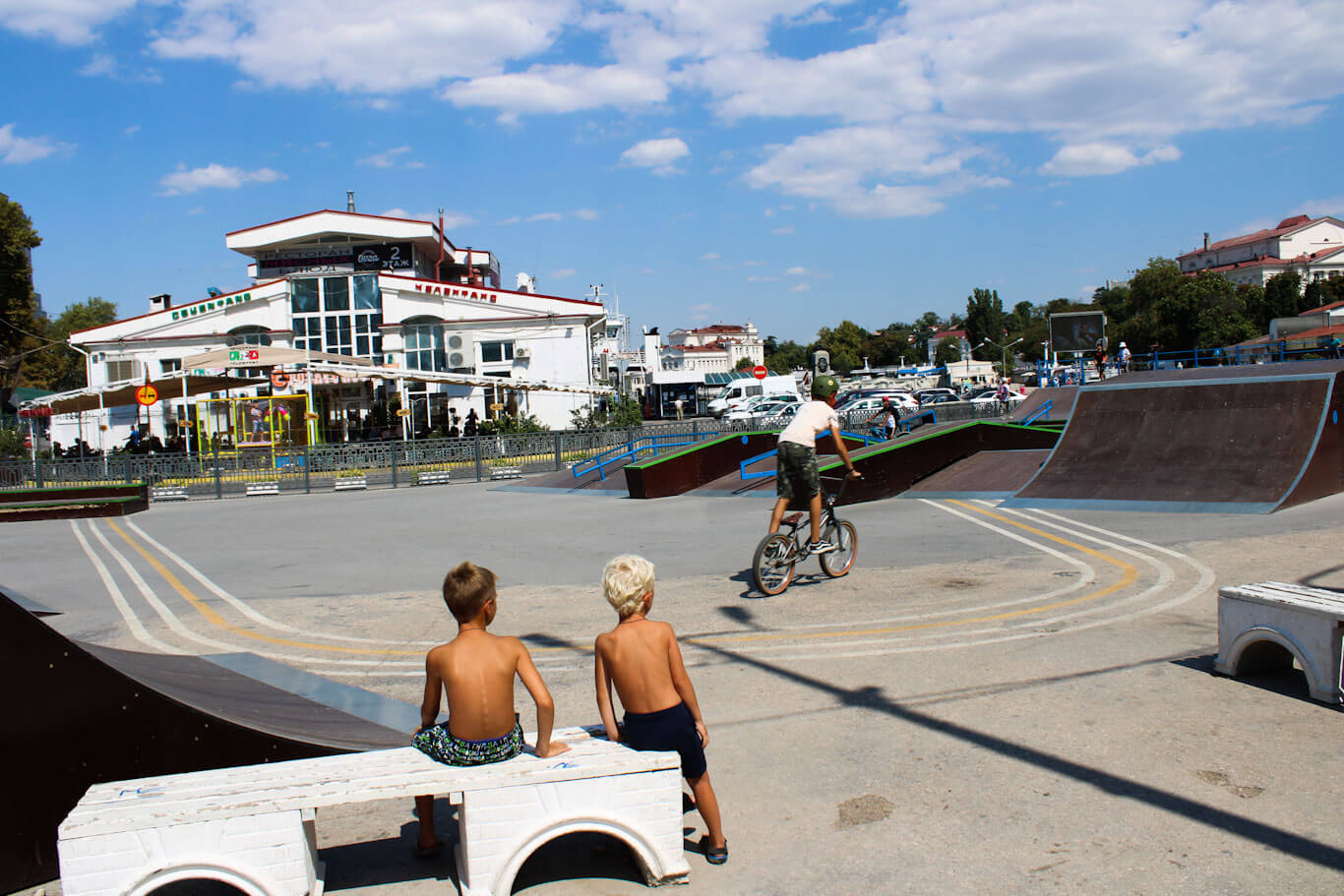
Young boys enjoy a local skate park near the Yalta coast. Photo | Eva Bartlett
I asked Tata about how life had changed after the referendum:
When I came here in December 2012, everything was dilapidated and run down. The nice roads you were driving on, they didn’t exist when we were a part of Ukraine. I didn’t understand why Crimea was still a part of Ukraine. It was Russian land ever since the Tsars, the imperial time of Russia. This is where the Russian soul is, and the soul of the Russian navy.
After the Soviet Union collapsed, it wasn’t the will of the Crimean people to join Ukraine. People were always Russian here; they always identified as Russian. Ukraine understood this well, and put nothing into Crimea, as punishment. Ukraine didn’t build any hospitals, kindergartens or roads.
In the past four years, the Crimean government has built 200 new kindergartens. This is the most obvious example of how things have improved. They also built the new Simferopol airport.
I worked in aviation. It took three years to build an airport of this standard in Yekaterinburg, Russia. It took half a year in Simferopol.”
International Jazz Festival
On my third day in Crimea, we drive eastward anew, driving for hours through the gorgeous countryside, along winding and rolling roads flanked by jagged mountains, past an exceptionally beautiful church (Nicholas Church Lighthouse) overlooking the coast, and down along the sea through more touristy seaside towns and past lines of day tents along the beach. The local FM radio plays a variety of both Russian and Western songs.
Finally, after night falls, we drive into the city of Koktebel, where an annual Jazz Festival is starting.
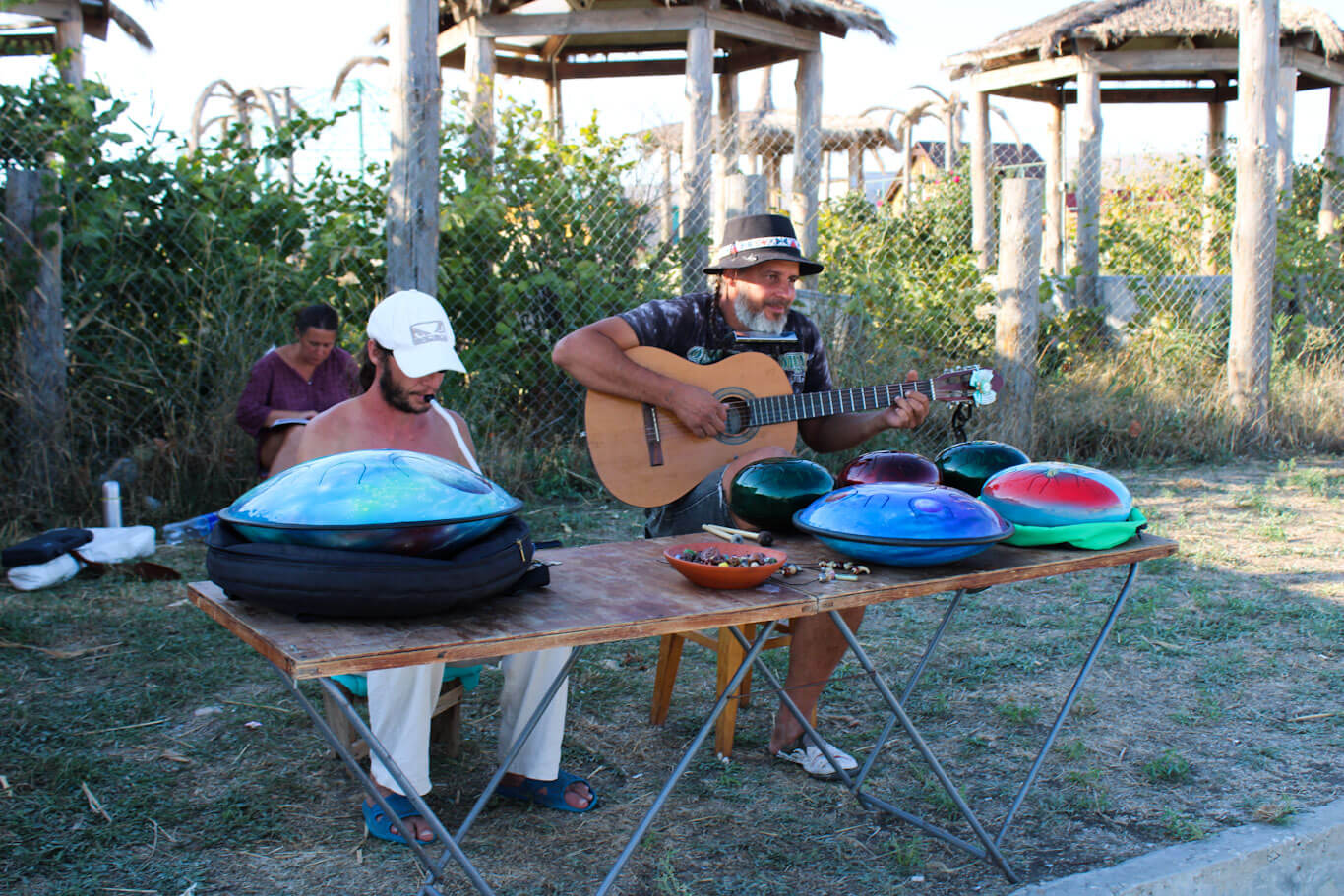
Buskers entertain passersby at the annual Koktebel Jazz Festival. Photo | Eva Bartlett
During all these hours of driving, the roads are smooth and well-trafficked, and I don’t see a single Russian military vehicle.
The next day, I walk through Koktebel, taking in the local markets brimming with produce, cheeses, and other goods, and every so often come across a streetside stand laden with fresh fruits. In the late afternoon, I walk along the sea, past packed beaches, and meet with a Crimean woman, Yaroslava, who lives in Austria but every summer returns to her beloved Crimea. She is ardently supportive of the decision to have joined Russia and spends much of her time back in Austria trying to educate people on why Crimeans wanted to be a part of Russia.
These are reasons I hear throughout my travels in Crimea: We wanted to be able to speak our native language [Russian] and be educated in that language; we wanted to be able to practice our cultural traditions; we have always been a part of Russia and we wanted to return.
Yaroslava is busy helping out with the Jazz Festival and wants to use the rest of our short time talking to help me arrange future meetings with people in Crimea. We decided to do a proper interview via Skype in the future when time allows.
I drift on to the Jazz Festival, where a talented pianist and band play beach-side to an enthusiastic crowd. Some songs later, I drift back along the beach, passing numerous musicians busking, and a pulsing nightlife that isn’t going to bed any time soon.
Construction everywhere
On the fifth day, we drive back to Simferopol; Vlad is heading back to Moscow. As we drive, we see road work repeatedly, just as we had when driving from Simferopol south to Alushta: roads being widened, repaved; bridges being repaired or newly built. This is something I observed throughout my travels around Crimea. I remember Tata’s words about “everything being dilapidated” and have a hard time imagining that now with what I see.
Vlad departs for Moscow, and I’m on my own now, traveling from the airport via public bus and minibus. At one point I ask a young couple, using Yandex translate, for directions. They get me on the right minibus and, following my route via Yandex maps, I get myself to Simferopol’s rail station and walk the half-hour to my nondescript hotel. I again need to ask locals for directions, as the unmarked hotel is in some parking lot behind a supermarket.
I retrace my steps to the train station the next day and repeat the routine to buy a ticket for Sevastopol. The ticket is 119 rubles (just under $2). Over the next two hours on a slow train with wooden seats, I watch as more beautiful scenery and construction slide by.
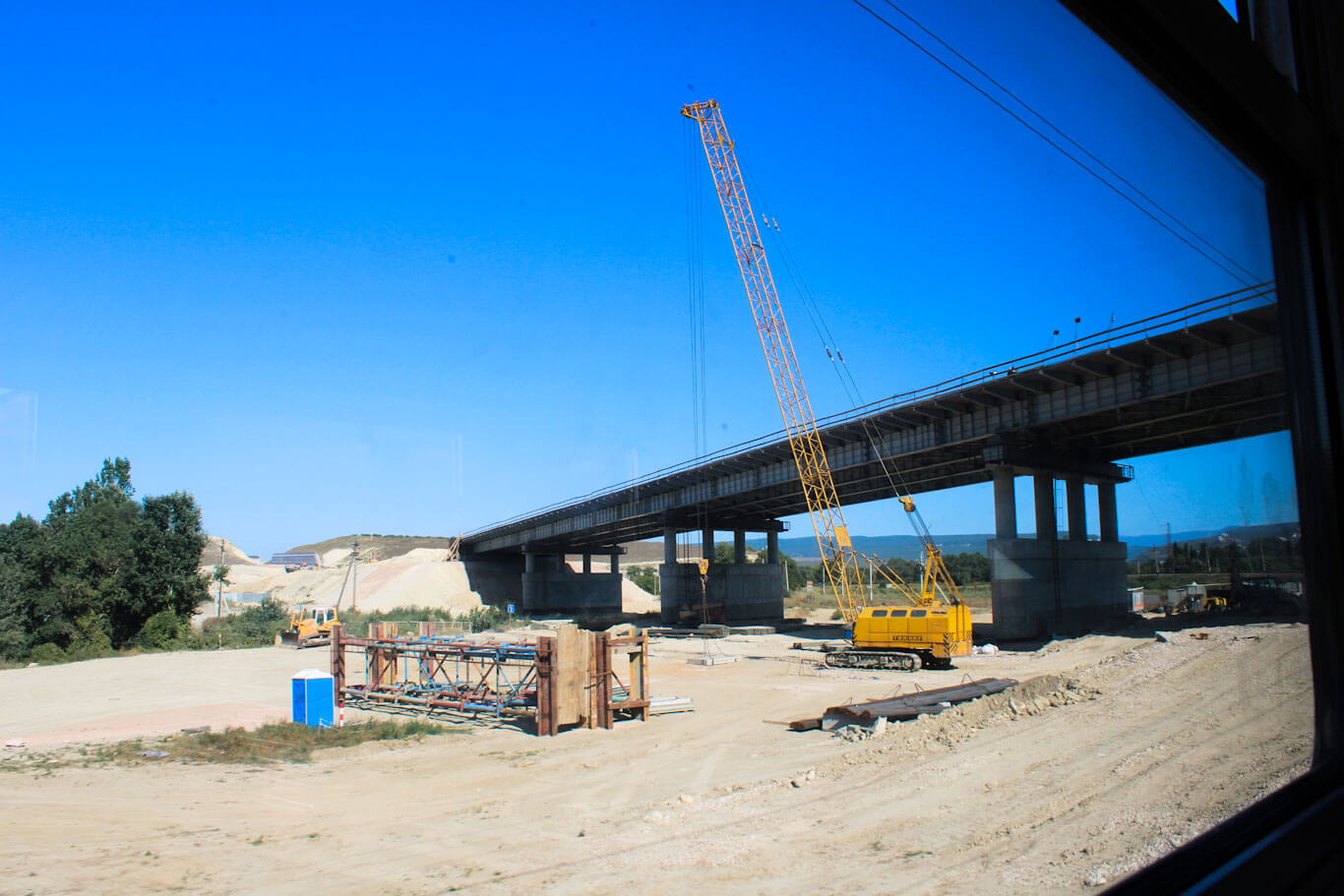
Construction dots the train ride to Sevastopol. Photo | Eva Bartlett
Arriving in Sevastopol, I leave the train station and hope to find some cafe where I can charge my phone, as I need it to navigate to the guesthouse where I’ve theoretically reserved a room online.
As I stand to orient the map route and zoom in to look for any signs of cafes, a woman walks by me and says with a smile something with the word “shto,” which I think means “what.” When I reply in English, she laughs and flags down another woman, Yana, who speaks English well and insists she and her husband drive me.
As we drive, we chat. I ask her about the referendum, mentioning that many in the West have the notion that it was done under duress, with a heavy military presence to influence the vote. She laughs, saying: “There were no troops, no military, around us during the referendum.” She speaks of the joy of Crimeans to vote, says that maybe 98 percent of Sevastopol voters had voted in favor [it was apparently 96 percent, but close enough], and adds, “We are now under the wing of Russia.”
I ask about developments since then. She mentions the improvements in roads, also the modern trolley-buses and regular buses, the opening of kindergartens and schools, and free courses (like music) for children.
We arrive at the remote guesthouse, where we realize that no one is home to give me a room. Yana mentions her parents have a guesthouse just outside the city and overlooking the bay. We drive to it, I meet the owners, charming people who set me up in a little apartment surrounded by fig and pear trees and with a small swimming pool to cool off in.
They invite me for dinner, but I have to politely decline in order to get back to work, though I do take a few minutes to enjoy their pool, the stars, the silence, and the incredible fragrance of some night blossoms.
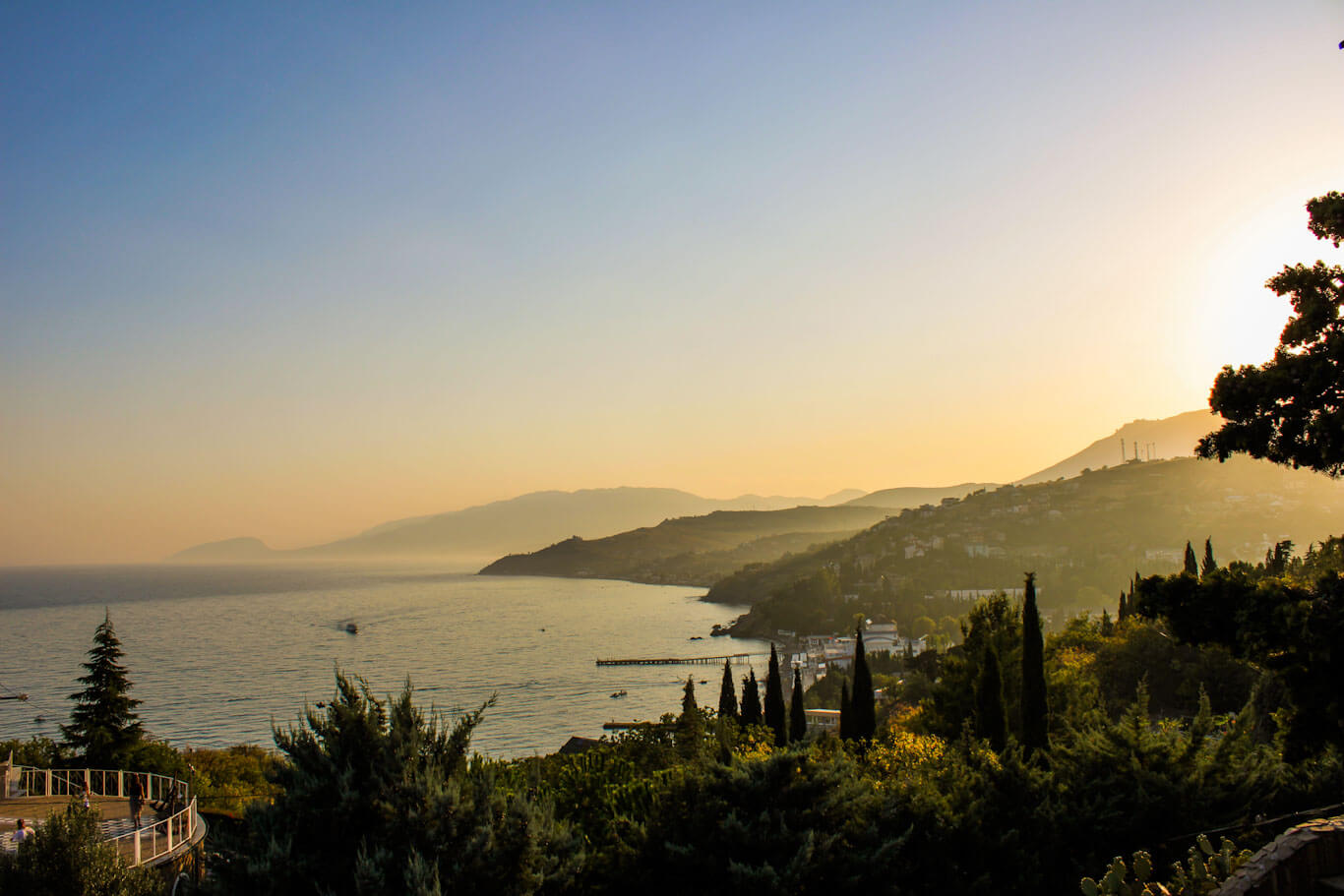
The stunning Sevastopol Bay. Photo | Eva Bartlett
The next few days, when not working on my laptop, I go for walks in the area, take in Sevastopol Bay, and one day take a minibus into the city and walk for hours around it, seeing some of the key sights.
When I finally need to leave Sevastopol for Simferopol again, the couple refuses to take my money, insists I am their guest, and drives me to the bus station, stopping en route at a market where they search for ten minutes until they find the traditional Armenian treats they want to give me: walnuts covered in the syrup of various fruits (pomegranate, peach, currant, grape), and a box of walnut-stuffed dried figs.
Ukrainians in Crimea
In Simferopol anew, I meet Anastasiya Gridchina, the Chair of the Ukrainian Community of Crimea, an organization formed in 2015 whose main goals, she tells me, “are to have friendly relations between two great peoples: Ukrainians and Russians — not the politicians but the people. The second goal is to preserve inter-ethnic peace in the Republic between different nationalities.”
Gridchina explains that in Crimea there are more than 175 nationalities, just 20 less than in all of Russia, but in a very small territory. Hence the importance of preserving inter-ethnic peace. After Russians, Ukrainians comprise the second largest population in Crimea.
I asked Anastasiya whether she supported, much less participated in the referendum.
I worked very hard in order that we could have a referendum. I live in Perevalne, the last settlement in the mountains above Alushta. There was a Ukrainian military detachment which did surrender. In February 2014, I was among a line of people standing between the Ukrainian and Russian military detachments, to prevent any bloodshed. The fear that prevailed at that time was that nationalists from Ukraine would come here and we would have massacres.
In February, there was a confrontation outside the Parliament here in Simferopol. It was organized by leaders of the Mejlis — the Crimeans Tatars. On the other side, there were some pro-Russia organizations who were protecting the Parliament. They were far less [numerous] than the Mejlis. The Mejlis were armed with sticks and knives. There were clashes and two people were killed, but thankfully it didn’t escalate beyond that.
When the news came that there would be a referendum, people relaxed. They had a chance to express their point of view and 96 percent of the population of Crimea voted for Crimea to return to Russia.”
Since she is Ukrainian, I asked Anastasiya why she wanted Crimea to join Russia:
I’ve lived in Crimea all my life, and my language is Russian. And I know the history of Crimea, which has always been Russian territory, which has a history beginning with the Russian Empire and then the Soviet Union. So, it is Russian-speaking territory, first of all. That’s why I believe it should be in the Russian Federation, not in Ukraine.”
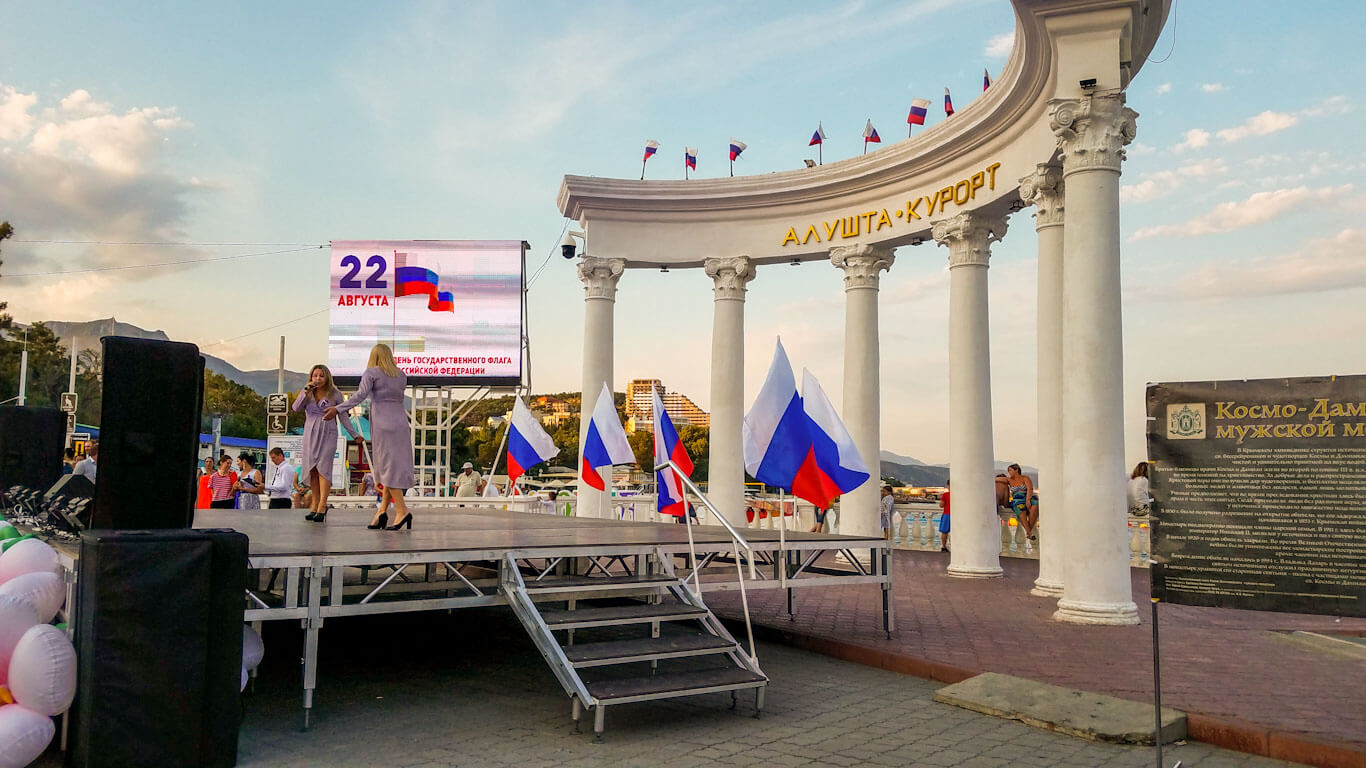
Singer entertain a crowd in Alushta on Russia’s National Flag Day. Photo | Eva Bartlett
I asked about the claims that Russian soldiers invaded Crimea:
Whatever they might have said about Russian soldiers forcing people to participate in the referendum, it was all lies, pure lies. We did not see any soldiers on the streets, especially on the day of the referendum.
I gave an interview to foreign journalists before the referendum. But when they published it, they changed my words. I said we were very thankful to the Russian troops that were here, that protected us from the attacks of Ukrainian nationalists prior to the referendum. But they translated it that I said ‘Please, we want Ukrainian soldiers to defend us from those Russian soldiers.’
The Russian troops that were here were not on the streets on the day of the referendum but, at the time in general, they were there to protect civilians from an attack by Ukrainians.
On the day of the referendum, there were no soldiers, no military. The only security were there to prevent any illegal actions. No military people were there, no arms, no armored personnel carriers, no military equipment, nothing. Only members of the election commission and the people voting.”
I asked whether many Ukrainian Crimeans left following the referendum:
There were those who immediately after the referendum left Crimea for Ukraine because it was their personal wish. Nobody prevented them from going. Even the soldiers had an option: to stay and continue military service here, or to leave.
There were also some people who didn’t like that Crimea joined Russia, but didn’t leave for pragmatic reasons. Because the quality of life in Russia is much higher than in Ukraine. So they continue living in Crimea.”
Finally, Anastasiya gave me a message for the people outside of Crimea:
I’d like to tell people around the world, welcome to Crimea, come here yourselves and see and hear with your own eyes and ears, to understand that all the lies you hear about Crimea, that we are oppressed or under pressure from the military…this is all lies, this is all not true.
Also, that we are not allowed to speak Ukrainian is a lie. One of the state languages is Ukrainian. Russian and Tatar are also state languages.”
As she leaves to go to the Ukrainian festival she has helped organize, she notes that the government allotted part of its budget towards financing the festival. She invites me to join. “You can see us singing Ukrainian songs, see our culture and traditions preserved.”
Next, I speak to Yuri Gempel, a member of Parliament, and the chairman of the Standard Commission on Inter-Ethnic Relations of the Parliament of Crimea.
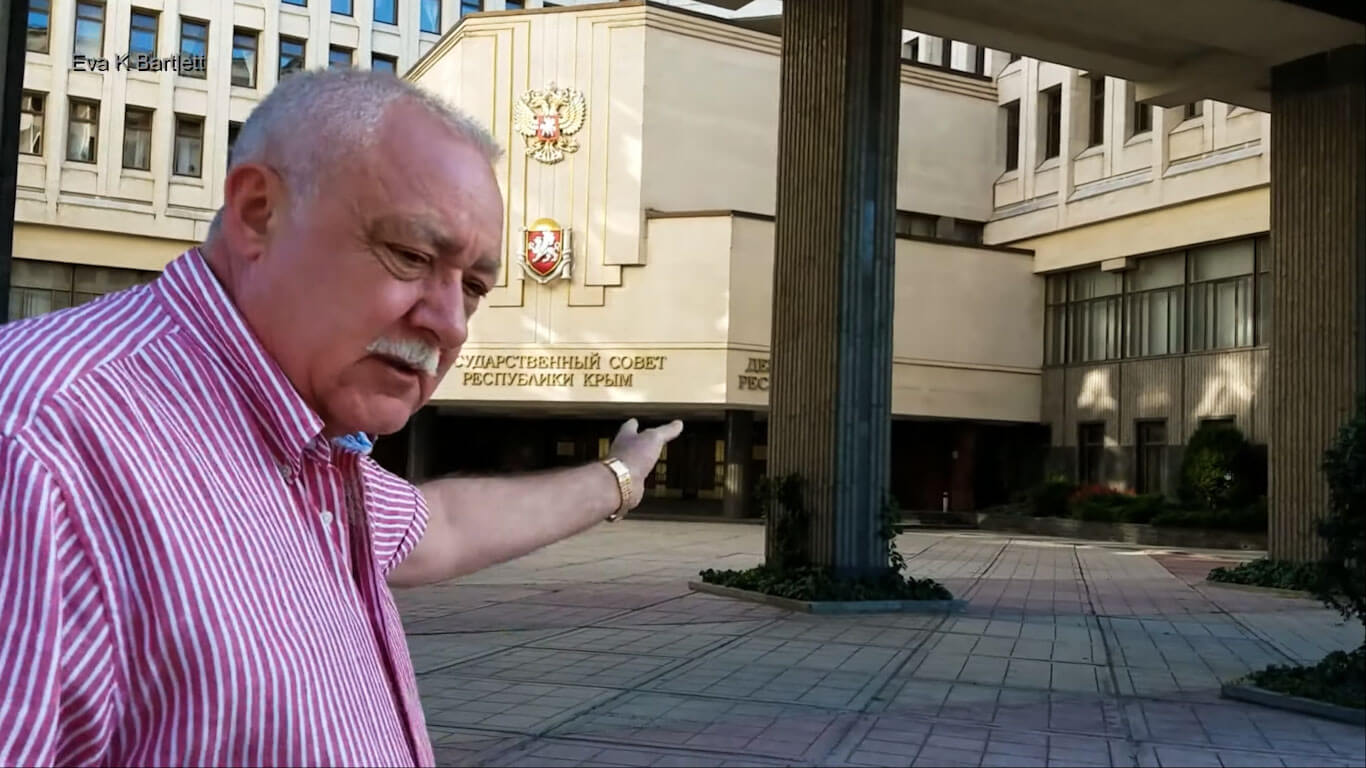
Yuri Gempel gestures to the location of clashes that broke out in 2014 between pro and anti-Russian protesters. Photo | Eva Bartlett
“Crimea, under Ukraine, was robbed,” Gempel says. He continues:
Everything was taken by the government and representatives of the ruling elite of Ukraine. For the 23 years Crimea was a part of Ukraine, they robbed Crimea. Not a single kindergarten was built in Crimea during those years. Kindergartens built during Soviet times stopped functioning.
But the main issue is that during that time, the people still felt themselves to be in Russian territory, not Ukrainian, in language, culture and in spirit. Under Ukrainian rule, Crimeans were made to speak Ukrainian, although Crimeans’ native language is Russian. People were deprived of the right to be in state service if they did not speak Ukrainian.”
I ask Yuri how things changed after the referendum:
After Crimea returned to Russia, an electric line exploded in Ukrainian territory and Crimeans were without electricity. Russia very quickly repaired and improved the electricity situation. We were also cut from water and food supplies immediately after Crimea returned to Russia.
As a result of the water shortage, we had to reform our agricultural production. We don’t produce rice now, because we don’t have enough water. But we grow wheat and other grains. And we introduced modern agricultural technologies, like drip irrigation. Now the economic situation has improved, and in some respects is much better than it was before.”
I then inquire about the 2014 clashes outside the Parliament, which Anastasiya Gridchina had mentioned:
I know the Chairman of the Mejlis of the Crimean Tatar People, Refat Chubarov, personally. I was there at the confrontation between the Mejlis people and pro-Russian groups at the entrance of the Parliament. I’m absolutely sure that Chubarov and his colleagues provoked the confrontations in which seventy were wounded and two were killed. It is their fault that anyone was wounded and killed. The main goal of the confrontation was to prevent the session in Parliament from happening; the points of the agenda of that session were about the referendum.”
I ask Yuri about another issue Western media refers to in its Crimea coverage: the alleged discrimination against the ethnic Tatars. Gempel imparts to me a history lesson:
In 1944, 190,000 Crimean Tatars were deported from Crimea; this was the largest ethnic group deported. Also Armenians, Germans, Greeks, Bulgarians.
In the over 23 years Crimea was in Ukraine, the various ethnic groups demanded the government issue a decree to rehabilitate those deported people.
In April 2014, after Crimea joined Russia, President Putin immediately issued a decree regarding the deported people. After the decree was issued, a federal program was adopted, with a budget of 10 billion rubles, which included building multi-storey buildings and improving the infrastructure in the areas returned deportees live in. The amount of money is much more than what was given by Ukraine in the 23 years that Crimea was part of Ukraine.”
Tatars make up around 11 percent of the population, Gempel tells me, but “have representatives in all branches of power in Crimea, including legislative and in the Parliament.” As Anastasiya Gridchina mentioned, Tatar is one of the three state languages, after a resolution on this was adopted by Parliament.
Standing outside the Parliament, where the 2014 clashes occurred, Gempel explains where he was at the time, and says there were no Russian soldiers or tanks. Then laughing, he points toward a tank monument in a park nearby: “There was only that tank. It’s been here since 1944.”
Although I want to stay for the Ukrainian festival, I’m heading to the Donetsk People’s Republic in the coming days, so instead I take yet another bus ride, this one a four-hour-long ride eastward to Kerch, the city from which the next day I am to cross the Crimean bridge back to the mainland.
I decide to use a ride-share program and arrange to join a car going early the next morning from Kerch and on to Rostov-on-Don, from where I will go westward to Donetsk.
We cross the impressive 17 km-long bridge. It is early morning and is also the day before children return to school, so the bridge isn’t busy. However, by early October, 6.6 million tourists have already visited Crimea, said to be a 10 percent increase from last year, and I can see why.
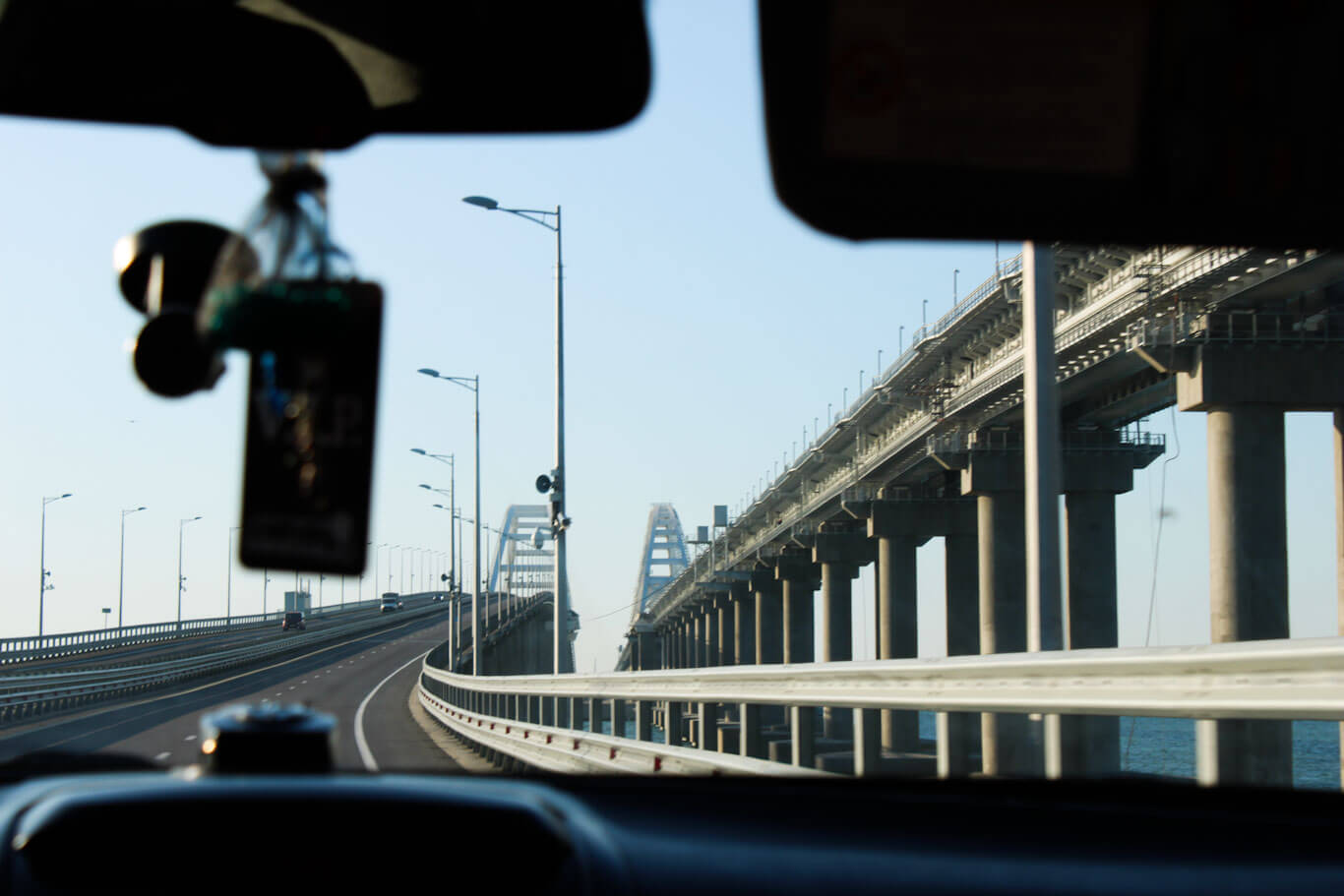
The nearly 11-mile long Crimean Bridge was completed in 2018. Photo | Eva Bartlett
Having spent over a week traveling by car and local transport in this utterly beautiful setting, I know I will be returning to Crimea when the opportunity affords itself.
As for the claims that Russia invaded Crimea and of Russian forces intimidating voters, I believe the many people I met who denounced those claims and articulated very clearly why they wanted to join Russia, or as they say, “return to Russia.”
Return to Russia: Crimeans Tell the Real Story of the 2014 Referendum and Their Lives Since
 TheAltWorld
TheAltWorld 
0 thoughts on “Return to Russia: Crimeans Tell the Real Story of the 2014 Referendum and Their Lives Since”